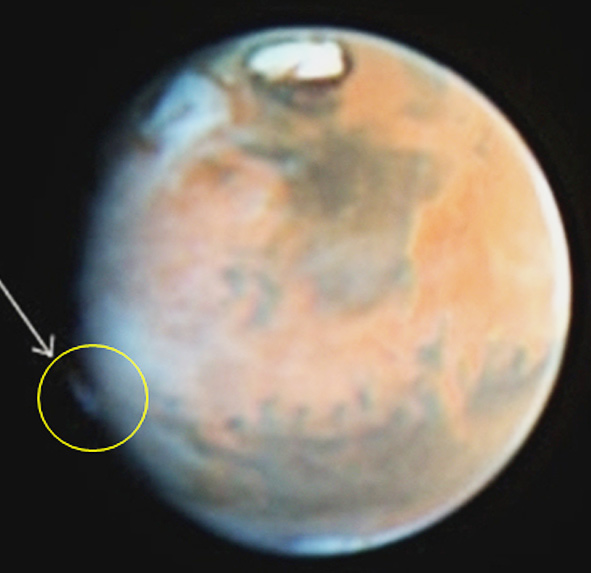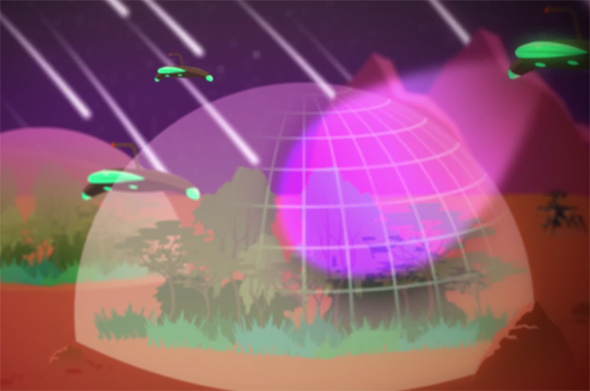Update: Mysterious Martian Plumes May Be From a Solar Storm and Not an Impending Invasion
In early 2012 a mystery literally erupted on Mars. Well, above it.
Amateur astronomers viewing the Red Planet from Earth noticed weird features on the limb of the planet (the edge as seen from Earth) in March and April 2012. They appeared to be clouds or plumes of some sort, but they were huge, and several hundred kilometers above the surface of Mars. No cloud has ever been seen that high, nor is there any obvious way to make one or get one there.
The features were definitely real; others have been seen (including with Hubble). Lots of ideas were considered—volcanic plumes, aurora, and so on (though Martian war machines were ruled out fairly quickly)—but nothing quite fit.
Now though, astronomers analyzing data from the Mars Express orbiter may have found a solution. Mars got hit by a solar storm.
Mind you, this isn’t conclusive, but it’s promising. Here’s what’s what.
A solar storm is when the Sun throws a magnetic tantrum, blasting off huge clouds of subatomic particles. These events carry a great deal of energy, and their own magnetic field. If they hit the Earth and interact with our magnetic field they can cause aurorae, blackouts, and other issues.
Mars doesn’t have a strong magnetic field, but it’s there; it’s only a couple of percent as strong as Earth’s, mostly due to magnetized rocks left over from when Mars did have an actively generated field (which has since shut down). And, in fact, the magnetic field is known to be a bit stronger over the region where the mystery plumes were seen.
A Mars plume spotted on March 20, 2012. Photo by W. Jaeschke.
Mars Express has been orbiting the planet since 2003, and is equipped with an instrument called ASPERA-3 that studies the interaction of particles from the Sun with the Martian magnetic field, and another one called MARSIS that uses radar to study the atmosphere and look for water under the surface. Looking over the data, scientists found that there were large space weather events around the same time both plumes were seen.
They did not see any obvious effects of this in the Martian ionosphere, the high altitude layer of the atmosphere where the molecules are stripped of electrons and become ionized. This is where you’d expect to see the biggest effect, so that’s a little odd, but it’s also known that the ionosphere in that region of Mars is “disturbed” due to the magnetic field there, so it’s hard to identify anything that would make it even more jinky.
Interestingly, Hubble observed a plume like this in 1997, and it turns out there was also a solar storm that might have hit Mars just before that observation was made. It’s not certain, but it’s compelling.
So what causes the plume? We know that the Martian atmosphere is being slowly stripped away by the solar wind, the more or less continuous stream of subatomic particles blowing off the Sun. Although the details are complex, and not fully understood, what may be happening here is that a storm from the Sun accelerates that process, compressing the Martian magnetic field, exposing the upper atmosphere to the direct effects of the storm. This allows more of the atmosphere to leak into space than usual, which we see as the plumes.
Mind you, this is still fairly conjectural; the evidence is indirect and circumstantial, but it does fit the idea that the storms caused the air over Mars to be extra leaky. Storms like this are rare, and detailed observations of Mars from Earth aren’t done around the clock, so they can miss the effects. Even orbiters around Mars itself may be in the wrong place at the wrong time to catch the effects.
The only way to know for sure is to catch one in the act. The best witness for that would be orbiters on the spot, but even observers from Earth can be crucial. Like seeing asteroid impacts on Jupiter, the more people we have observing Mars the better.
It makes sense to me. It’s easy to believe that in the early years of the 21st century that world would be watched keenly and closely; across that gulf of space, intellects vast and warm and sympathetic would regard Mars with curious eyes, and slowly and surely draw their plans to understand it.




